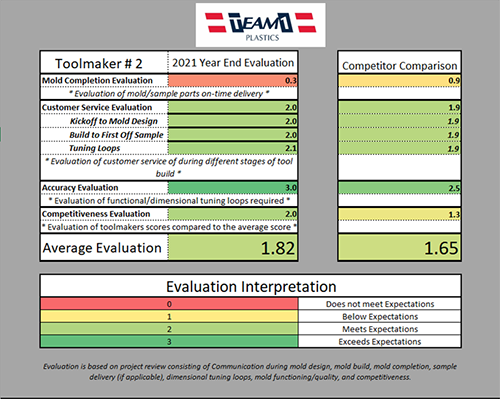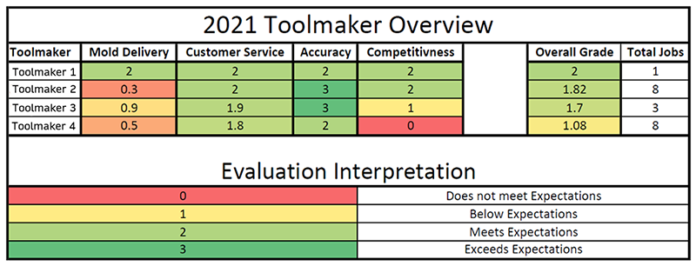by Danielle Sheldon, marketing assistant, Team 1 Plastics,
and Nicole Mitchell, editor, Plastics Business
For the plastic injection molding industry, it is essential for some decisions to be cost-driven. With supply shortages taking their toll on molders across the globe, a cost-driven strategy can be beneficial to the annual outcomes of all involved.
There can be, however, opportunities for improvement that lie outside the “cost-driven” component of doing business. Team 1 Plastics, a plastic injection molding company for the transportation industry, has done just that with the company’s Toolmaker Grade Sheet.
Team 1 Plastics was founded in 1987 by three plastics engineers, Jim Capo, Craig Carrel and Gary Grigowski. The company started as an international automotive supplier focused on providing materials to the Japanese market. However, in recent years, the company has expanded to include customers in other locations, including Europe, Asia and North America. The company creates small precision components for the automotive industry that perform at a top rate.
In 2019, Team 1 Plastics’ Engineering Manager Dave Seedorf brought a unique idea to light. Seedorf was considering a new approach to improving the company’s decision-making process for evaluating its toolmakers. Not only would this new Toolmaker Grade Sheet allow for data-driven decision making as the company grows, but it also would eliminate subjective considerations when evaluating toolmakers.
Originally, Team 1 held a close relationship with three to four toolmakers and used them regularly; however, there wasn’t a process for evaluating their processes and results. The companies that Team 1 worked with were doing a good job, but sometimes it would get stuck in a loop of using the same toolmakers over again. “One of the toolmakers we used asked how many tools we made,” Seedorf said. “I shared the information, and they wondered why they only built five or six things for us. It was a great question.”
Judging toolmakers based on issues outside of their control is another common issue in the manufacturing business – especially when shipping issues, pandemics and other natural disasters are occurring. “When you have a bad experience, you might take it out on them for a while instead of looking at the overall scope of business,” said Craig Carrel, co-owner. “Creating a standardized evaluation process allowed us to try to rate and treat them equally and fairly.”
While researching what other molders were doing, Seedorf discovered that, among the few toolmaker evaluations out there, the basis for evaluation was all driven by costs. It was important for Team 1 to develop a unique, yet effective, toolmaker evaluation that also would consider non-cost factors relating to accuracy and performance.
Evaluation metrics
Completed annually, the Toolmaker Grade Sheet is based upon a Zero to Three scale, with four evaluation metrics: Mold Delivery, Customer Service, Accuracy and Competitiveness. The scores for each toolmaker then are averaged to give a final “Overall Grade.”
 Although the Toolmaker Grade Sheet is given annually to toolmakers, the process of evaluation is ongoing throughout the year. Consistent data collection by the engineering team is done during weekly meetings and monthly data evaluation. “The engineering team meets monthly to discuss metrics,” Seedorf said. Questions the engineering team asks when meeting include: Are the tools submitted on time? Are there progress reports? What does this company’s turnaround time look like?
Although the Toolmaker Grade Sheet is given annually to toolmakers, the process of evaluation is ongoing throughout the year. Consistent data collection by the engineering team is done during weekly meetings and monthly data evaluation. “The engineering team meets monthly to discuss metrics,” Seedorf said. Questions the engineering team asks when meeting include: Are the tools submitted on time? Are there progress reports? What does this company’s turnaround time look like?
“There are several points we talk about for each project, each month,” Seedorf continued. “We use a 1-2-3 scoring system. One is below expectations, two is at expectations and three is above.”
Points of evaluation include the following metrics.
Mold delivery: The interpretation for Mold Delivery is determined by on-time delivery of the mold/sample parts. For example, Toolmaker #2 has received a 0.3 for Mold Delivery. This toolmaker averaged a delivery time that “Did Not Meet Expectations” – a much slower delivery time than quoted.
Customer service: The interpretation for Customer Service is determined by the molder’s experience as a toolmaker’s customer. This could include aspects such as the toolmaker’s supply of weekly timeline updates, response to correction plans in a timely manner and answering questions as needed. This evaluation metric is the only one that could be construed as somewhat subjective, as it is based upon the interactions of the engineering team members during different stages of the tool build.
Accuracy: The interpretation for Accuracy is determined by the number of dimensional tuning loops required on a tool. A dimensional tuning loop is the process of making corrections to a particular tool. “Meeting expectations would include one, maybe two, tuning loops for a tool,” explained Seedorf. A toolmaker also must hit the timing quoted for tuning or they can fall to “Below Expectations.” In contrast, Toolmaker #2 was awarded eight jobs in 2021 and had no tuning loops on several of those tools, awarding them with an “Exceeds Expectations” grade of 3.
Competitiveness: The interpretation for Competitiveness is determined by comparing the average grade to other toolmakers in the evaluation. This can be particularly important for toolmakers to see how they fit in with other toolmakers. When there are obstacles to success – such as steel pricing, delivery costs, shortages and pandemics – it may be occurring with more than just one toolmaker.
Post-evaluation – Feedback and improvement
Developing the toolmakers’ “Overall Grade” is made easy by the ongoing data collected throughout the year by the engineering team.
At the end of January, each toolmaker receives both an individual Year-End Evaluation and the Toolmaker Overview. “We send out a personalized email,” Seedorf explained. “Our project engineer, Mitch Hemgesberg, puts them together and provides a summary of where the toolmaker is in our assessment.” Year-end evaluations are done interactively to allow toolmakers to ask questions and truly understand where they stand vs. receiving a simple document or report.
This type of data-driven evaluation can be advantageous for both molders and toolmakers. When the toolmakers know they are being evaluated and ranked against others, it drives improvement and fosters positive relationships between molders and toolmakers.
The annual feedback serves as constructive criticism, giving the toolmakers a “target” to hit for improvement. As the toolmakers improve, they are awarded more business from the molders and the molders can be confident they are doing business with quality toolmakers based on data, rather than opinion.
Toolmakers are not the only ones who need feedback. Beginning this process has given Team 1 the opportunity to receive feedback from its toolmakers as well. “Most responses have been very positive,” Seedorf said. “And some toolmakers schedule regular meetings with us to discuss further so that they know what to do to improve. It’s impressive.”
For plastic injection molders, decision making for good business should not always be driven on cost alone. With a data-driven evaluation that considers metrics based more on performance and accuracy than cost, molders and toolmakers alike can benefit. Now is the time to ask, “Could it be time to revise our toolmaker evaluation?”
Danielle Sheldon started with Team 1 Plastics in 2016 as a production assistant and then quickly moved up within the company as trainer, developing a Production Assistant Training Program to improve turnover rate and reduce production errors. After some time away from the company, she returned to Team 1 in November 2021 as its marketing assistant. She received her Bachelor of Arts in Social Work in 2011 from Michigan State University.
More information: 517.414.6661, www.team1plastics.com or daniellesheldon@team1plastics.com





